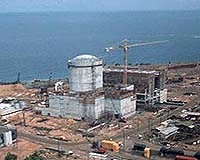 |
Tokyo (UPI) May 11, 2011 Japan said it would abandon existing plans for nuclear power expansion, as the country Wednesday marked two months since an earthquake and tsunami crippled the Fukushima nuclear power plant. "Under the basic plan for energy in 2030, the proportion of nuclear energy and total electricity supply would be 50 percent for nuclear energy and 20 percent renewable energy," Japanese Prime Minister Naoto Kan told reporters Tuesday. "But with the occurrence of a major nuclear disaster, the basic plan for energy is going to have to be reviewed thoroughly, from scratch." Kan pledged that, from June, he would forego his prime ministerial salary until there was prospect of a resolution at Fukushima. "I believe the government bears a major responsibility for having promoted nuclear energy as national policy. I apologize to the people for failing to prevent the nuclear accident," he said. Kan's announcement came as the first wave of nuclear evacuees who lived within the first exclusion zone of Fukushima were permitted to visit their homes to retrieve their belongings. The prime minister said renewables would become a key part of energy policy, admitting his country's renewables sector has lagged behind that of Europe and the United States. Renewables, he said, "should be regarded as one of the major pillars" in a new plan. Japan ranks 15th in the world in terms of the attractiveness of its renewable energy markets and policies, an Ernst & Young study shows. Wind power, for example, now supplies 2.3 gigawatts, or 0.4 percent, of Japan's energy. But the Japanese Wind Energy Association aims to boost that to 50 gigawatts by 2050, with an interim target of achieving 11.1 gigawatts of capacity by 2020. Speaking to BusinessGreen ahead of Kan's announcement, Yoshinori Ueda, director of JWEA, said he was cautiously optimistic that, in the long term, the Fukushima crisis would represent a boost to wind power. Only one of Japan's 1,742 wind turbines didn't survive the quake, Ueda said, and two wind farms located within the Fukushima 18.5-mile evacuation zone were forced to temporarily shut down. Ueda said a feed-in tariff was needed to drive investment, but FiT legislation has been delayed. "Without a FiT, no financiers will invest in new wind power development because without a subsidy these projects are not economical," Ueda told BusinessGreen. "New wind power developments have almost stopped now because of the delay of the FiT law."
Share This Article With Planet Earth
Related Links Nuclear Power News - Nuclear Science, Nuclear Technology Powering The World in the 21st Century at Energy-Daily.com
 Philippine nuclear plant to become tourist site
Philippine nuclear plant to become tourist siteManila (AFP) May 11, 2011 Tourists will soon be able to wander through a nuclear power plant in the Philippines that was built nearly three decades ago but never used, a government official said Wednesday. The Bataan Nuclear Power Plant, which has lain dormant since it was completed in 1984 at a cost of $2.3 billion, will be opened to tour groups to teach them about nuclear power, said regional tourism director Ronal ... read more |
|
| The content herein, unless otherwise known to be public domain, are Copyright 1995-2010 - SpaceDaily. AFP and UPI Wire Stories are copyright Agence France-Presse and United Press International. ESA Portal Reports are copyright European Space Agency. All NASA sourced material is public domain. Additional copyrights may apply in whole or part to other bona fide parties. Advertising does not imply endorsement,agreement or approval of any opinions, statements or information provided by SpaceDaily on any Web page published or hosted by SpaceDaily. Privacy Statement |